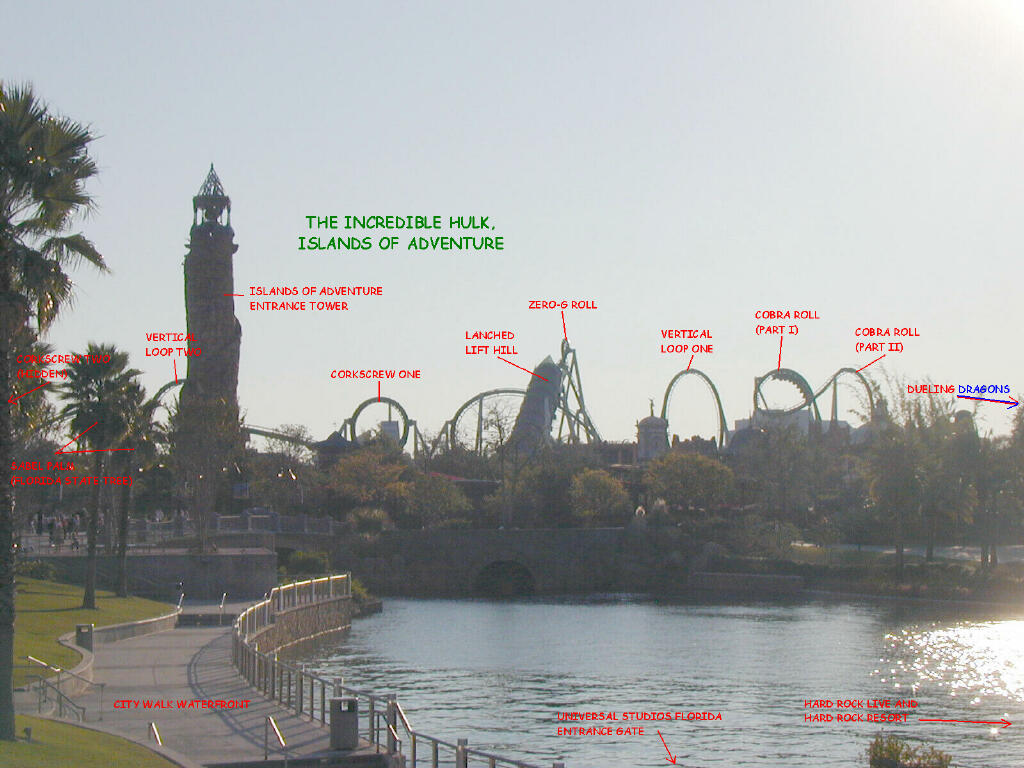
Click here for a larger version of this picture with Hulk's inversions labeled.
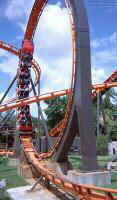
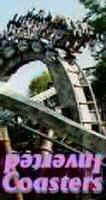
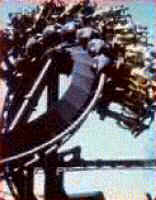

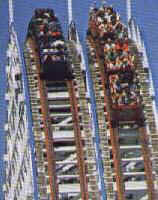
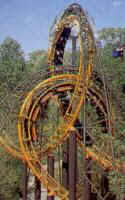

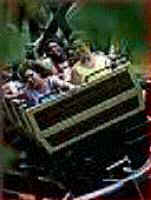
Here's a list of necessary coasters, most hated coasters and most missed coasters.
01. Montu
Busch Gardens, Tampa Bay (Tampa Bay, FL)
Designer: Bolliger and Mabillard (B&M) of Switzerland
Type: Inverted coaster
Material: Steel
OH MY! Basically all one can say after
riding this most incredible of roller coasters. Dubbed a "specialty ride" by a
friend who, after riding, declared that a machine of this nature "couldn't even be
considered a roller coaster," Montu is probably the most dominating, powerful roller
coaster I have ever experienced. This of course, meaning that the rider is entirely out of
sorts from beginning to end with the overhead tracks out of view and therefore providing
no hint as to what sneaky maneuvers B&M has in store.
The maneuvers at the beginning of the ride start at a very large scale and gradually get
smaller and smaller towards the end of the ride so that the speed seems to constantly
increase. Brakes have been added, but even with those, the batwing provides a wonderful
sense of actually flying out of control headed for collision. All is safe, of course, and
Montu throws in a couple of corkscrews half buried in the ground before the ride is over.
In true Busch fashion, this ride is very well themed, so much so that Montu is treated
like a true showpiece. The ride area, queue, spectator areas and Egypt section all become
completely merged as the ride flips over and dives under walkways. Live alligators are
underfoot, and you feel somewhat caught in Montu's clutches even before you board. If
rides got grades, this one would have an "A++!"
See Montu See Greg's Review
of Montu on Theme Park Insider!
02. The Florida Hurricane (The Roaring
Tiger)
Circus World (Hanes City, FL--Near Orlando)
Designer:
Rosser of North America
Type: Out-and-back coaster
Material: Wood
Maybe this one remains so high on my list
for the simple reason that it's been years and years since I've ridden it. I was a lot
smaller then and this ride seemed a lot bigger and faster. But if memory serves me
correctly, it's one of the best examples of the classic "out-and-back" ever
assembled. Quick acceleration, good airtime and nothing to get in the way of a fast, fun
ride. It's sadly been long gone from Florida due to the fact that (not so sadly) Circus
World has also long since vanished from central Florida. At last report, the coaster had
been moved to a little park in Arkansas called Magic Springs. The ride has had a
couple of million dollars of restoration and has been re-christened the Arkansas
Twister. Odd, since anyone that knows anything about coasters knows that an
out-and-back is basically the opposite of a twister. But perhaps they were
referring to the tornado kind of twister. Yes, perhaps that. The Magic Springs
website has a little picture of the ride as well as a video.
See The
Florida Hurricane (Arkansas Twister)
03. Kumba
Busch Gardens, Tampa Bay (Tampa Bay, FL)
Designer: Bolliger and Mabillard (B&M) of Switzerland
Type: Sit-down coaster
Material: Steel
The Roar of The Cat! And this one truly
does roar!! B&M is known for their distinctive sound and Kumba was my first B&M
ride. Not only does it sound great (maybe I should make a new list based on sound
alone--Montu would still win) but I love the way the coaster involves the onlooker by
crossing the entrance walkway and displaying all of its maneuvers in breathtaking view.
Busch are the absolute masters in the industry for combining coasters and their
theme park environment.
See Kumba
04. Giant Dipper
Santa Cruz Beach and Boardwalk (Santa Cruz, CA)
Designer: Arthur Looff of USA
Type: Twister coaster
Material: Wood
This one is all about the beginning before
the lift hill. I'm not sure who actually thought of taking riders on a dip into darkness
(at a rather nice clip I might add) before sending them to the lift hill to begin the
ride, but those few turns and dips in the dark are what make this ride so unique. There's
nothing like taking someone on the Dipper for the first time and watching their expression
of surprise at the ride's intro. A gasp, then giggles. Perfect combination. Designed by
Arthur Looff who borrowed nicely from Fred Church's Bobs style coasters, this one
is a classic in its own right as well.
See Giant Dipper
05. Racer
Kings Island (Paramount's Kings Island) (Kings Island, OH--Near
Cincinnati)
Designer: John Allen
for Philadelphia
Toboggan Company (PTC) of USA
Type: Out-and-back coaster
Material: Wood
Sentimentally my favorite ride, this was
the first "real" roller coaster I ever rode. Nice acceleration, lots of hills
AND it races! (The Blue Racer always wins). The best part about this one, as compared to
its sister, Rebel Yell at Paramount's Kings Dominion, is that half-way through the
"out" portion, the two tracks split apart just for the fun of it. They just
don't build them like this anymore where a coaster can be good simple fun. If you happen
to have the chance, ride the coaster both forwards and backwards. I think you'll agree
that forward is definitely better.
*Trivia tid bit No 1: The Racer is usually credited for beginning the second
"Golden Age of the Roller Coaster." The first Golden Age was in the
1920s, and the second is still in progress, with more coasters being built
yearly now than ever before in history.
*Trivia tid bit No 2: The Racer is featured in episodes of both The Partridge
Family and The Brady Bunch.
See Racer (the
Paramount's Kings Island website also has a video of the Racer)
06. Screamin' Eagle
Six Flags Over Mid-America (Six Flags St. Louis) (Eureka, MO--Near St. Louis)
Designer: John Allen
for Philadelphia
Toboggan Company (PTC) of USA
Type: Out-and-back coaster
Material: Wood
Can someone say paint job? Another classic
John Allen design (funny, I don't care for Six Flags Over Georgia's Great American Scream
Machine at all) this coaster unfortunately looks like hell right now, which is a shame
because it's such a graceful and beautifully put together coaster. There's a natural slope
that runs underneath it and allows the ending to have some nice sized dips and actually
makes the third drop of the coaster the longest rather than the first. In true Six Flags
style, the ride isn't themed at all, but they have managed to keep a nice amount of trees
around the coaster so that you feel as if you rushing through the woods miles away from
the busy park. The hills never seem to stop coming and the train keeps good speed right to
the very end.
*Trivia tid bit: The Screamin' Eagle was John Allen's last roller coaster. He is
one of the most famous coaster designers ever to have lived, and had been in
retirement for years until Kings Island shook him up and got The Racer (see
above) out of him. He then went on to design Six Flags Over Georgia's Great
American Scream Machine (1973) and then the Screamin' Eagle for Six Flags Over
Mid-America in 1976, shortly before he died.
See Screamin' Eagle
07. Mind Bender
Six Flags Over Georgia (Atlanta, GA)
Designer: Anton Schwarzkopf
of Germany (for INTAMIN of Switzerland)
Type: Looping speedracer
coaster
Material: Steel
It's all about the ending on this one! I
love the second half of the ride. The beginning is normal enough with a hill and a loop,
but then the gully next to the first hill is used to make the remaining portion of Mind
Bender truly mind bending. The so-called second loop (really a banked 360 turn) is a lot
of fun even though it's not the loop they promised. The G force is great on the turn and
it circles what they call the third loop, but of course, it's actually only the second.
The ride then gives us quick hill, a turn and a super fast hill into the last loop which
is a great ending punch. Can't ride this one enough. Painted a very dark gray (almost
black) for years, the Mind Bender (not to be confused with Schwarzkopf's Canadian ride
Mindbender)
suddenly turned a rusty red for a few years and has now gone all green with black question marks to resemble Riddler and play off its new
neighbor,
Batman: The Ride. The paint job is nice enough, and only goes to remind us that
Six Flags needs to paint ALL of their roller coasters more often than they do.
See Mind Bender

Click here for a larger
version of this picture with Hulk's inversions labeled.
08. The Incredible Hulk
Universal Studio's Islands of Adventure (Orlando, FL)
Designer: Bolliger and Mabillard
(B&M) of
Switzerland
Type: Launched
sit-down coaster
Material: Steel
It took me quite some time to finally give
in to my bias against Universal Studios (being the Disney leaches that they are) and
satisfy my curiosity for their venture into a less-movie, more thrill based park. While my
bias against Universal will never really disappear, I was quite impressed with their
command of crowd management, themed queue lines and most importantly, use of high powered
thrill rides. The Incredible Hulk was the top the park had to offer. How many B&M
coasters can you ride and still be totally amazed by the combination of
inversions? Apparently quite a few, for this is my most recent B&Mer and it ranks
quite highly on my coaster list. Hulk begins before you even enter the queue, with the
ride diving under and soaring over the park's main walkway (Islands is a "circle
park" so the main walkway is really the only walkway). Clearly visible from the
get-go is the zero-g roll, the impressive cobra roll and the first of two vertical loops.
Slightly more hidden are a rather odd corkscrew and a second vertical loop. Completely
hidden is the final corkscrew inversion. To say it's a well-paced ride is a huge
understatement. Hulk literally burst into the first maneuver from a launched lift hill
that routinely takes riders by surprise, even if they've ridden it before. You're
immediately turned upside down through a somewhat effective zero-g roll, and before you
realize it, you've flipped twice more (over a lake at this point) in the giant cobra roll.
You finally focus just in time to hit the vertical loop. B&M, unlike competitors Arrow
Dynamics, treats vertical loops as ride elements that are not always the first
encountered. Placing the large vertical loop as the fourth inversion is quite tasty. From
this, you're swept under the main (only) walkway and then around a tight spiral before
hitting the first corkscrew. This type of B&M corkscrew should actually have a
different name since it's rather unique to this firm and is somewhat unbalanced
in feel and appearance. This would be quite a ride should it have ended here, but Hulk
continues to speed through a tunnel, another vertical loop, a break run (which doesn't
slow him down at all) and the final corkscrew. It's a blast of a ride, and is equally good
in the front or the back. In fact, first timers should always do the very front seat (it
has its own queue line) simply for the view and the total rush of launching with nothing
in front of you.
See Hulk
09. Batman: The Ride
Six Flags Great America (Gurnee, IL--Near Chicago)
Six Flags Great Adventure (Jackson, NJ--Near NYC)
Six Flags Magic Mountain (Valencia, CA--Near Los Angeles)
Six Flags Over Mid-America (Six Flags St. Louis) (Eureka, MO--Near St. Louis)
Six Flags Over Georgia (Atlanta, GA)
Six Flags Over Texas (Arlington, TX--Between Dallas and Ft. Worth)
Designer: Bolliger and Mabillard
(B&M) of
Switzerland
Type: Inverted
coaster
Material: Steel
Bigger is most certainly not always
better, and Batman: The Ride is a perfect example of how tight radii (radiuses) on a
coaster's maneuvers really makes them that much more intense. The two corkscrews at the
end of this ride are breathtaking just viewing from the queue as rides are whipped through
them with visible force. It's a great one to have the sensitive-tummied do three times in
a row!! If you can't get to Six Flags Magic Mountain to ride this one, have no fear. Batman:
The Ride has been cloned in several Six Flags parks nation-wide, with the
original being in
Six Flags Great America in Illinois. Great Adventure, St. Louis, Georgia and Texas
also have versions, with the Texas clone the first to show up in bright yellow. The others
are either gray and blue, black and gray or some variation of those darker Batman colors,
with the St. Louis version actually being a mirror image of the others taking riders on a
right turn off the lift hill rather than a left one.
*Trivia tid bit: The Batman tv show featured a Batman costume that was gray and
dark blue. It wasn't until the movie versions of Batman that black became his
primary on-screen color. Each version of Six Flag's Batman: The Ride combines
colors for track and trains that either pay homage to the tv Batman, the comic
book Batman or the movie Batman.
See Batman: The Ride
(Roller Coaster Database has pictures of several of the Batman clones, including
a couple of that very odd yellow Texas version)
10.
Roar
Six Flags Marine World (Vallejo, CA--Near San Francisco)
Designer: Great Coasters
International (GCI) of USA
Type: Twister coaster
Material: Wood
Roller coasters are very funny things,
especially the wooden ones. When this little ditty opened in 1999, a good buddy dubbed it
"the perfect backyard coaster," meaning, of course, that it was fun, but about as
exciting as a backyard swing. Well, things change, and to be honest, I think (as well as
some other people) that Marine World must have completely torn down Roar and rebuilt a new
ride. "Roar 2000" is nothing like the tame, mid-sized twister that once stood in
the parking lot (Marine World really needs some help on placing its rides) near the
entrance gate. This "new" coaster, while still mid-sized, is super fast, full of
airtime and able to produce giggles and screams from an entire train-load of passengers.
And what about those trains! The Millennium Flyers (as GCI has named this style
of train) are the same as they were in 1999, but now they actually get proper use since
Roar moves fast enough to make you realize why the specialty, very flexible trains were
designed in the first place. It's NOT just an aesthetic thing.
*Trivia tid bit: The Millennium Flyer trains that GCI designed for Roar
are name in honor of the famous Century Flyer trains that National
Amusement Devices (NAD) designed for wooden roller coasters almost a century
ago. The GCI trains are especially interesting in that they are
"articulated trains", an industry term for trains that are very
flexible due to the fact that the train cars are only one seat deep, rather than
two or three seats deep as is common on most coaster trains.
See Roar
11. The Beast
Kings Island (Paramount's Kings Island) (Kings Island, OH--Near Cincinnati)
Designer: Charles Dinn for Kings Island Construction of USA
Type: Terrain coaster
Material: Wood
Listed in Webster's under woodie (the
coaster enthusiast term for wooden roller coaster), is there anything about The Beast that hasn't already been said? Long
enough so that even after a couple of hours in line, you still start to wonder just when
it's going to end. Not that you want it to of course. I have to say I love a coaster in
the woods and The Beast looks right at home surrounded by trees with the first hill taking
riders away from the park into the wilderness. At night, there are no lights on the
Beast, which make it super fun with big Ohio Bats flying over your head. Well, you can
imagine there are bats at any rate.
*Trivia tid bit No 1: In 2000, just in time for the latest millennium and just after
of the end of The Beast's 20th Anniversary celebration (it opened in 1979),
Kings Island opened Son of Beast. Son of Beast became the first wooden hypercoaster
(over 200ft high), the first wooden coaster to have a loop, the
second longest wooden coaster in North America (The Beast is the longest) AND
the first ever coaster sequel. Pretty cool, huh?
*Trivia tid big No 2: The Bat reference (purposely a proper noun) is not just a
silly author's comment. Indeed for a brief period in the early 1980s, Kings
Island operated a unique suspended roller coaster (the first of its kind) near
the Beast that was produced by USA firm, Arrow Dynamics. This suspended coaster
hung from overhead tracks, and the trains had cars that could swing individually
as far as 130 degrees. The coaster, because of its odd hanging configuration,
was called The Bat.
Unfortunately The Bat didn't survive more than a few years, and it was replaced
in the mid 80s with Arrow Dynamics's Vortex.
See The Beast
12. Riddler's Revenge
Six Flags Magic Mountain (Valencia, CA--Near Los Angeles)
Designer: Bolliger and Mabillard
(B&M) of
Switzerland
Type: Stand-up
coaster
Material: Steel
Batman and his enemies have finally
given Six Flags some remote grasp on theming, and fortunately for this one, the ride lives
up to its name. When I first saw the pics of Riddler being tested and the green on the
trains, I thought the photos had been color-enhanced. Could the green really be that intense?
Turns out, it
was, and aside from a rather weird transition from the lift hill to the mini-curve before
the first drop (has anyone else noticed that?) the ride is flawless. Well, maybe those big
trim brakes in the middle could go, but even so it's a rush from beginning to the almost
hidden corkscrew at the very end. Riddler holds the distinction of being about the only ride
that I actually like the front better than the back, which is impressive enough in itself.
*Trivia tid bit: When Six Flags Magic Mountain opened Riddler's Revenge, the
ride featured a techno-styled soundtrack that blasted continually from the queue
area. Seems that the music itself became an attraction for teens and coaster
enthusiasts alike. I'm not a big fan of techno (okay, not even a small fan of
techno), but I've learned that the piece is called "Ecuador" by artist
Sasha. There are actually several remixed versions that float arond the net, and
the "hear" link below will take you to one of them (although it's a
slightly different version that actually plays in the ride's queue).
See Riddler's Revenge
Hear Riddler's
Revenge!
13. Medusa
Six Flags Marine World (Vallejo, CA--Near San Francisco)
Designer: Bolliger and Mabillard
(B&M) of
Switzerland
Type: Floorless
coaster
Material: Steel
After a point, it almost gets worthless to
add another B&M ride to any coaster lover's list. Basically any one that you've ridden
becomes one of your favorites right away (except maybe Great Bear in Herseypark). Odd thing is though that Six Flags Marine World,
which the author still doesn't consider a real park, has two fantastic coasters, and
Medusa is truly a world class ride sitting of course, in the park's parking lot. Crummy
location and complete lack of theming aside, this is a fantastically beautiful, extremely
smooth and super fun ride. ("Fun", of course, being a perfectly allowable
adjective in describing roller coasters.) Medusa starts with a non-curving drop (unlike
its New Jersey sister) which is always scarier. The maneuvers are for the most part
typical B&M (if anything about their maneuvers can be considered typical) but this
Medusa throws in a couple that are worth mentioning. The third inversion is a zero-g roll
that actually works!! Designers have thrown in zero-g sections of track for a good while
now, but the float time in Medusa's roll is far beyond anything that's been achieved so
far. You actually don't realize how much you're floating until pulling out of the roll
when you hit the TOP of the shoulder restraints. The fourth inversion is the standard
entrance to a cobra roll, but instead of the usual exit, the fifth inversion of Medusa
changes direction so that you leave the cobra roll (renamed a "sea serpent" for
this coaster) on the opposite side that you began. Truthfully, the original cobra roll is
better, but this is kind of cool, feeling like a very long double corkscrew.
See Medusa
14. Dahlonega Mine Train
Six Flags Over Georgia (Atlanta, GA)
Designer: Arrow Dynamics of USA
Type: Mine train
coaster
Material: Steel
This one is obviously not on here for the
thrill factor, but for the fun factor. Of all the mine train type rides out there, this
one is my favorite. Very jerky and a bit rough, this mine train never fails to make me
(and everyone else) giggle at the slight drops and many turns. The tunnel at the end is a
classic, and yes, it still hurts just a little when you get thrown against the side of the
car, but it's just a pure joy to watch everyone laughing at the fact that the
hill caught them so off guard.
See Dahlonega
Mine Train
15. Big Thunder Mountain Railroad
Disneyland (Anaheim, CA--Near Los Angeles)
Walt Disney World Magic Kingdom (Lake Buena Vista, FL--Near Orlando)
Designer: Walt Disney Imagineering of USA
Type: Mine train
coaster
Material: Steel
I'm a coaster rider who happens to also
be very into the "theme" at theme parks, something, oddly enough, most
"theme" parks don't seem to be into at all. While often criticized by scholars
and amusement park purists alike, it's important to understand that theming
isn't really a desire to replace the "real" world. At its very core,
theming has a sense of humor and a sense of fun. Rather than thinking that
theming is trying to recreate the real old west, imagine that theming is
imitating the imagined old west, or perhaps the movie western. Do that,
and you'll totally understand what its' about. Disney, quite naturally
understands theming rather well, and sometimes gets so carried away with theming that you
can't possibly enjoy it all while riding. Big Thunder is an example of just that since
many of the ride's details rush by while you're in the middle of laughing with little kids
who are experiencing their first roller coaster and big kids that just like to laugh. It's
fun in a purely fun sort of way and the painted rocks, flying bats (on strings no doubt),
railroad ties (underneath the entire length of the track, which is a wonderful detail) and
the little engines in front of the trains, make this the "cutest" roller coaster
in the world. I've always claimed to like WDW's version better than Disneyland's, simply
for the way it's positioned in the park. Disneyland's does allow for greater viewing from
the walkways however. Disneyland's version is also shorter than the Florida
version. There are also versions in Tokyo and
Paris, with the
Paris version designed by Dutch coaster firm, Vekoma. The new version being
built for Hong Kong will also have Vekoma on board as co-designers with Walt
Disney Imagineering.
*Just as a little trivia tid bit for you physical geographers (love the tid bits), the detailed rockwork of
Disneyland's version is designed to look like Bryce Canyon, Colorado, while the
version in Florida's Magic Kingdom has rockwork (concrete, steel and loads of
paint actually) that is set to look like Monument Valley, Utah.
*Extra trivia bit: Big Thunder has several trains running in and around it. It
must take a lot of guts to be a little train racing through the quaking,
bat-filled Big Thunder Mountain, and that's evidenced in the names of the
trains. Next
time you board, look at the engine of your train for the name. The different
train names are as follows (read the initials like words):
U.R. Courageous
I.M. Brave
I.M. Bold
U.R. Fearless
I.B. Hearty
U.R. Daring
See Big Thunder Mountain
Railroad (California's version)
Big
Thunder Mountain Railroad (Florida's version)
16. Mr. Freeze
Six Flags Over Texas (Arlington, TX--Between Dallas and Ft. Worth)
Six Flags Over Mid-America (Six Flags St. Louis) (Eureka, MO--Near St. Louis)
Designer: Premier Rides of USA
Type: Launched (LIM)
coaster
Material: Steel
Pulling up the end of my list is this
powerful little number that once again has played off a Batman bad boy. Mr. Freeze has
completely vertical sections of track and that alone make it worth the experience. But the
real thrill is the launch, and while not as fast as Superman's, is just as effective
before throwing you into a crazy "high-hat" inversion after a completely
vertical, 90-degree incline. The only negative aspect to Freeze (and also the reason it's
at the bottom of my list) is that it's simply far too short. Forward/backward
(shuttle) rides have
never been faves of mine for that very reason, and were it not for Freeze's rather odd
inversion AND completely vertical tower AND high-tech launcher (ok, that's a lot of things
isn't it?) I don't think it would make the list at all.
See Mr. Freeze
Worst Coasters on the Planet (at least that I have ridden)
-01. Kong
Six Flags Marine World (Vallejo, CA--Near San Francisco)
Designer: Vekoma of The Netherlands
Type: Suspended looping coaster
Material: Steel
Vekoma International has done some
interesting work with Disney on Big Thunder Mountain Railroad (Paris) and more
notably, Rock N Roller Coaster at the MGM/Disney Studios and the Walt Disney
Studios. The Disney/Vekoma projects allowed Vekoma to stretch itself a little
and actually show that they can do more that what they are more famous for,
which is slightly less glamorous. Basically, Vekoma is a firm most noted for
their ability to design low-cost, small footprint rides for parks that either
don't have a lot of money, don't have a lot of space or both. They've created
the boomerang, which is the most duplicated coaster in the world. They've done a
few more coasters that have become industry "off the shelve"
standards, almost in the way Huss or Zamperla produce flat rides. One of those
creations popped up in Six Flags Marine World just as the park was undergoing
its massive transformation into a Six Flags park. Kong speeds riders from a
height of 115' through five inversions, including a roll-over and a sidewinder.
Problem is, Kong is really just no fun. The seats are small, even smaller than
Arrow's steats, and in general, their trains are very light, which doesn't make
for a very forceful ride. There is also an incredibly un-smooth transition from
the holding block brakes to the station, that even though it's hit at less than
10mph, it still hurts. On top of everything, it's just simply boring. A
coaster can not be scary, as long as it's fun. But to lack all personality is
just pathetic, and the contraption is the ultimate in personality-less
coastering.
See Kong
-02. Ninja
Six Flags Over Mid-America (Six Flags St. Louis) (Eureka, MO--Near St. Louis)
Designer: Arrow Dynamics (Arrow Development) of USA
with Vekoma of The Netherlands
Type: Looping coaster
Material: Steel
The Vekoma-bashing continues with this
most banal of thrill coasters. How can a coaster 110ft high with four inversions
be boring? Ask Vekoma, they seem to be masters at it. Ninja begins with a
standard lift hill, but instead of taking full advantage of the height and
dropping riders 100 feet, Ninja drops less than half that distance, which gives
the train just enough speed to make it through two loops. There's little sense
of actually dropping down a hill, which at some level is supposed to be a good
bit about what thrill coasters are all about. Mid course, the train hits the
trim brakes and comes to a near full-stop before inching along and hitting
another very small hill before going through two corkscrews. Again, the
inversions are not the problem, it's the complete lack of full drops that makes
Ninja uninteresting. Another very strange aspect of the completely tired Ninja
is its peculiar placement in the park. Six Flags is notoriously bad at
presenting its thrill rides to park visitors. Routinely they place rides in
areas that used to be parking lots, and most often they fence them off from
guests so that you never get to see a train racing directly overhead or stand
underneath a loop or whatever. Ninja contains four inversions which would be
interesting to watch from walkways around the ride, yet, the ride is turned so
that all four inversions are on the back side of the coaster away from the
walkway. You have to look through the net of supports for the lift hill and
brake run to see any of the looping portions of track. So in spite of being
boring to ride, Ninja is also just plain dull to look at.
See Ninja
-03. Grizzly
Marriott's Great America (Paramount's Great America) (Santa Clara, CA--Near San
Jose)
Designer: Kings Island Construction of USA
Type: Twister
coaster
Material: Wood
For the obvious reason of the name, one
might think that I love this coaster. :-) Truth is, however, this coaster often
rivals Kong and Ninja as what is probably the worst coaster on the planet. It's
just almost impossibly to imagine that this coaster came out of the same idea
factory as The Beast and Grizzly (the Kings Dominion Version). Both this Grizzly
and the one at Paramount's Kings Dominion are modeled on the famous Wildcat of
Cincinnati's Coney Island, which was closed to make way for Kings Island, later
to become Paramount's Kings Island. The Wildcat was a John Miler original, and
built by the Philadelphia Toboggan Company. Paramount got the plans for the
coaster, and revived the Wildcat in the form of the Grizzly to great success at
Kings Dominion. There was another copy made for Paramount's Canada's Wonderland,
and then Paramount made the Great America version. Something went desperately
wrong this third time around and Great America ended up with a dud. They idea
was to scale down the thrill factor somewhat and make the coaster more suitable
for a family coaster as Paramount was pushing Great America to be more of a
family park, rather than a thrill park. Thing is, the coaster was toned down too
much. The drop angles were minimized to the point of making the train hardly
move down the hills, and to avoid maintenance, Great America slowed the train
down even more by applying trim breaks a several points during the route. In the
end, for a coaster its size, it is a huge disappointment.
See Grizzly
-05. Ninja
Six Flags Magic Mountain (Valencia, CA--Near Los Angeles)
Designer: Arrow Dynamics (Arrow Development) of USA
Type: Suspended coaster
Material: Steel
Six Flags Magic Mountain and Arrow team up
again to produce yet another amazingly uneventful ride, also named Ninja.
Granted, the suspended coaster never managed to become the trill maker Arrow had
originally hoped after The Bat closed due to maintenance problems. However,
rather than attempting to re-market the ride as a bland family coaster, Arrow
still tried to push it as a thrill ride, and consequently several more versions
appeared in North American theme parks during the mid 80s, with the best being
the Big Bad Wolf in Busch Gardens, Williamsburg. Ninja, unfortunately, didn't
have that coaster's final drop over a river, or its sense of storyline, which
helps the Big Bad Wolf stand out as the only surviving suspended coaster with
any spunk. Ninja winds and twists its way around a flume ride and over a
walkway, all the while leaving riders if the train will have enough speed to
make it back to the station.
See Ninja
-06. Flashback
Six Flags Magic Mountain (Valencia, CA--Near Los Angeles)
Designer: Intamin (with Giovanola) of
Switzerland
Type: Hairpin coaster
Material: Steel
One problem with Six Flags Magic Mountain
having so many coasters (it's tied with Cedar Point for the park with the most
coasters on the planet) is that a lot of them are really pathetic. Flashback
came on the coaster scene in the 80s as Z-Force. Six Flags passed this ride
around to a couple of parks before it got renamed and ended up in Magic
Mountain. This very unique "hairpin" coaster is the only one of its
kind built, no doubt because of the extreme lameness of the ride experience.
There's much more to making a good coaster than many people realize, and much of
that is not in the height of the ride or the number of hills or inversions. It's
in the "story" the ride tells, or its pacing of its elements. Like in
the way a movie can be good or bad, not because of the actors per se or the
overall direction of the plot, but more so in how the movie is directed, how the
suspense builds and releases itself. Coasters are no different, and Flashback
suffers from taking the idea of the hairpin curve, but then not developing the
concept to include other ride elements that would round out the complete story.
The idea is that after ascending the lift hill, riders are swept through a
series of near-inverted, hairpin curves. The hairpins themselves are not the
back part of the ride. Problem is, that's all the ride does. In between
each curve is a flat piece of track that the train travels across at very slow
speeds until it reaches the next curve. Back and forth, back and forth. There's
no real climax to the end of the ride, except for the fact that two of the
curves come closer together. Even though the ride was never repeated, it's still
not a hopeless concept, it just needs to be incorporated into a more fleshed out
ride design that highlights the hairpins, but doesn't rely on them solely to
make the ride interesting. In spite of everything, I applaud Six Flags for
keeping it running (albeit only on very busy days when ride capacity is of major
concern) and not dismantling it since it is one of a kind.
See Flashback